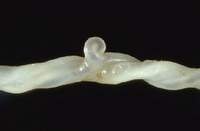Umbilical blood can cure 100 diseases
Our future is kept in an armored safe-like room that can withstand a 5-hour fire.

There is a sterile environment and filtered air in the room. Access to authorized personnel only. The future is hidden in the test tubes immersed in liquid nitrogen at minus 196 degrees Celsius. The room hosts a cryogenic center. It is located at a basement level of the Scientific Center of Obstetrics, Gynecology and Perinatology under the Russian Academy of Medical Sciences. The test tubes contain stem cells secreted from the blood of the newborn. Everybody seems to be aware of miraculous effects of the stem cells. But how can we tell a fact from a lie? An MK correspondent speaks with Academician Vladimir Kulakov, director of the above center.
Q: Is it true that stem cells were first discovered by Russian scientists, and then were “rediscovered” by Western scientists?
A: Yes, it is. But we were left behind in certain areas of research. The British produced the first test-tube baby back in 1978, later they performed the first cloning operation and brought out that sheep, Dolly. We kicked off our research on umbilical blood program a mere three years ago. We made the first stem cells in Russia.
Q: The term “stem cells” has been hyped big time by the Russian media. You can even see ads about “three-day rejuvenation programs” using stem cells.
A: Illegal activities of pseudo-medical commercial entities should be subject to criminal prosecution. Until recently, no hospital or clinic in Russia had had a license for the use of stem cells. Some time ago, a handful of research centers including our institution were licensed to use stem cells.
Q: What is actually a stem cell?
A: The stem cell is an immortal cell that is able to produce all the cells within an organ. The term is most usually applied to the hemopoetic stem cells of the bone marrow. Patents were reported to have recovered from the harmful effects of radiation after doctors transplanted a donor bone marrow to them. Later researchers learned how to secrete stem cells from the bone marrow. Then researchers found a way of secreting stem cells from the blood of an umbilical cord. The number of stem cells decreases as man grows older. For example, a 50-year-old human being has approximately 100 thousand stem cells. Now it is believed that stem cells from umbilical blood can be used for treating more than a hundred diseases. Today we inject the stem cells into a patient’s body in the hope to get them working on a damaged organ by transforming into cardiomyocytes in case of a myocardial infarction, or into hepatocytes in patients with cirrhosis.
Q: Could you please name some of the diseases which can be treated with the help of stem cells?
A: The diseases include certain kinds of leucosis, certain malignant tumors, which are usually incompatible with life. The stem cells can be used very effectively for treating strokes, myocardial infarctions, diabetes, chronic cirrhosis. We use the stem cells for treating stress-related enuresis at our center. Treating children with grave congenital malformations is the most important work done at our center with the help of stem cells. Russia is about to adopt the WHO classification that registers the newborn with weight starting from 500 grams and pregnancies lasting 23 weeks. These days the statistics are kept only for children weighing at least 1000 grams and pregnancies lasting 28 weeks. A newborn child weighing 500-600 grams becomes a statistic. However, he will be regarded as a late miscarriage if he does not make it.
Seventeen thousand children with the weight under 1,000 grams are born in Russia each year, only 3,700 of those children survive yet 67% of them become disabled. Russia’s infant mortality rate will instantly soar by 4 times if we switch to the WHO classification. There is about a million disabled infants in Russia. These are the horrifying figures.
Q: The first banks for storing stem cells were opened abroad in 1992.
A: Yes, there are commercial cryogenic banks in the U.S., Britain, Germany and other developed countries. A woman gives birth to a child, and blood from an umbilical cord is taken for safekeeping. It is an insurance of sorts should that child falls victim to an accident or something of the kind. The cells are stored in nitrogen for decades, they can be thawed and used for treatment. In the so-called public cryogenic banks it is the government that foots the bill for taking umbilical blood from women who gave birth. A minimum of 25-30 thousand samples is required for finding the right donor. Unfortunately, there is only one public cryogenic bank in Russia. It has about 1.5 thousand samples. They have to work for at least 4-5 years more in order to meet the requirements.
Q: What is the compatibility ratio for the cells from an umbilical cord’s blood of a child and his mother?
A: The ratio is 50 to 50 for a mother and a father. It is highly important to store a child’s stem cells whose parents are of different nationalities. Finding a donor is not always possible in this case. People of different nationalities have different blood specifics. Every year we discover new blood characteristics both at the molecular and genetic levels. In Russia, it is difficult to find a doctor for a patient with Caucasian blood, it is a lot more difficult to find a donor for a patient with Chinese blood. However, doctors will have no trouble in finding a donor if a child’s umbilical blood is stored and available.
Q: Are data of the Moscow cryogenic center is included in the world register of umbilical blood banks?
A: We have been officially certified in compliance with the international standards. We follow all the instructions of foreign auditors. A children’s hematology center will be built in Moscow shortly, but they have no material to use for treating children. Now they buy it abroad paying from $15 thousand to $20 thousand per sample. We are ready to set up a public cryogenic bank if the government allocates funds for necessary procedures required for taking blood of women who give birth at our center. The cost of special chemicals and equipment for taking and processing a sample of stem cells secreted from umbilical blood is in the neighborhood of $1,000.
Moskovsky Komsomolets
Subscribe to Pravda.Ru Telegram channel, Facebook, RSS!




